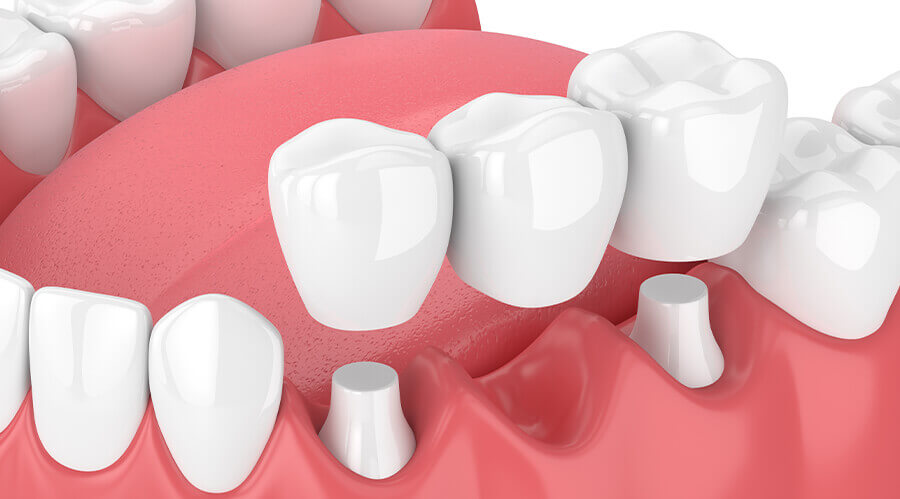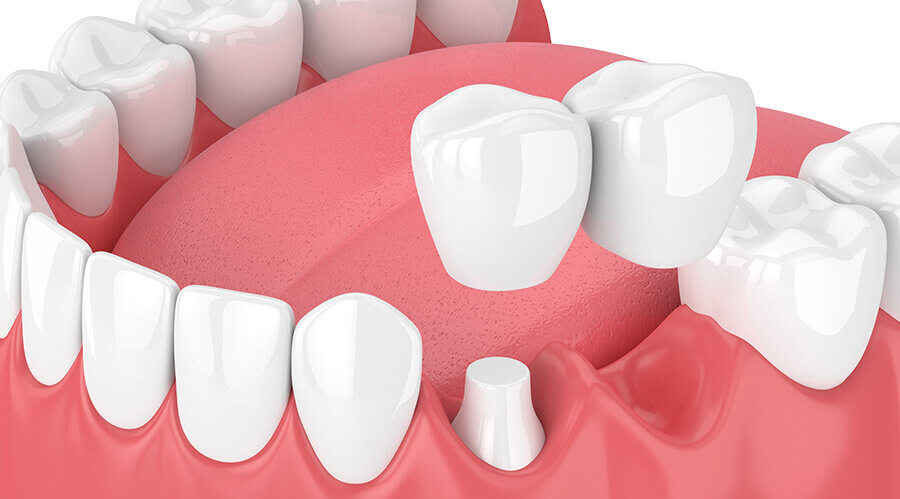In cases of tooth loss, our dentists often recommend dental bridges. It can be used to replace one or more missing teeth, supported by the adjacent teeth known as “abutment teeth.” Dental implants can also support the bridge, but more commonly, it is secured to the adjacent natural teeth after some enamel reduction and fitting of dental crowns.
Types of dental bridges
There are four main types of dental bridges that can be distinguished from each other.
Traditional dental bridge
This type consists of one or more artificial teeth held in place by dental crowns directly attached to the adjacent natural teeth. It is the most common type of dental bridge and is used when there are healthy natural teeth on both sides of the missing teeth to support the bridge.

Cantilever dental bridge
Similar to the traditional bridge, this type also uses dental crowns to support the artificial teeth, but only on one side, not on both sides. It requires a healthy natural tooth adjacent to the missing tooth, rather than two.

Maryland bridge
This type is also similar to the traditional dental bridge as it requires two natural teeth as abutments. However, instead of attaching the artificial teeth with dental crowns, they are attached with metal or porcelain on the backside of the abutment teeth. Like the cantilever bridge, it also requires two natural teeth, one on each side of the missing tooth.

Implant-supported dental bridge
As the name suggests, this type of bridge is supported by dental implants that act as the abutment teeth. Typically, an implant is placed for each missing tooth, and these implants hold the bridge in place. If placing an implant for each missing tooth is not feasible, the bridge can also be anchored to two implant-supported crowns. The procedure is usually done in two stages: first, the dental implants are placed into the jawbone, and on the second appointment, the bridge is placed.

The cost of a dental bridge
The cost of a dental bridge depends on several factors, including the number of teeth to be replaced, the materials used for the bridge, the complexity of the procedure due to the location of the missing teeth, and whether other dental treatments are needed (such as gum disease treatment). One advantage is that the process is generally faster and more affordable than dental implants, although the cost is influenced by the materials used for the bridge. Dental bridges can also be made from different materials, with the two most common types being metal-ceramic and zirconium-based bridges. The creation and placement of the dental bridge are always part of a personalized treatment plan.
The process of creating a dental bridge
Whether you choose a metal-ceramic or a zirconium dental bridge, the process of creating the bridge – at least from the patient’s perspective – is the same. First, the teeth are prepared by shaping them, and then an impression of the dental arch is taken, using an oral scanner to keep up with modern techniques. Next, the design of the crowns and the preparation of the abutments take place, where parallelism is crucial; otherwise, the bridge cannot be attached securely. The final step is cementation. Once the framework is ready, there is a framework trial, shade matching, and the final covering of the crowns. The last step is bonding the bridge to the abutments with a special permanent adhesive. There is usually no need for oral surgery, so there is no long healing time; the patient only needs to wait for the adhesive to set and the anesthesia to wear off, which usually takes a few hours. After that, the patient can eat, drink, speak, and laugh as if they never had any issues with their teeth.
Benefits of a dental bridge
Tooth loss can negatively impact everyday life in various ways. By correcting it with a dental bridge, the following benefits can be achieved:
- An aesthetic smile
- Proper chewing
- Correct bite alignment
- Proper speech and pronunciation
- Restoration of the lower facial shape
- Prevention of further dental damage and tooth loss.